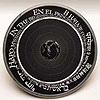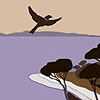 Fifty
to
ninety
percent
of
the
world's
languages
are
predicted
to
disappear
in
the
next
century,
many
with
little
or
no
significant
documentation.
Much
of
the
work
that
has
been
done,
especially
on
smaller
languages,
remains
hidden
away
in
personal
research
files
or
poorly
preserved
in
under-funded
archives.
Fifty
to
ninety
percent
of
the
world's
languages
are
predicted
to
disappear
in
the
next
century,
many
with
little
or
no
significant
documentation.
Much
of
the
work
that
has
been
done,
especially
on
smaller
languages,
remains
hidden
away
in
personal
research
files
or
poorly
preserved
in
under-funded
archives.image: Rosetta Disk, high density,
The Rosetta Project is a global collaboration of language specialists and native speakers working to develop a contemporary counterpart of the historic Rosetta Stone. The Rosetta Stone was found in the town of Rashid (Rosetta), Egypt by French soldiers in 1799. The text inscribed in the stone was written in three different languages of the region circa 196 B.C.E. and provided a resource for the translation of ancient hieroglyphics through the juxtaposition of more familiar language forms.
"The goal of the Rosetta Project is to produce a meaningful survey and [near] permanent archive of 1,000 languages and to create a unique platform for comparative linguistic research and education, as well as a functional linguistic tool that might help in the recovery or revitalization of languages that might be lost in the future. It is the hope of the Rosetta Project that its endeavor will help draw attention to language extinction and aid in the preservation (as more than indexes of languages) to further what the project feels is the "critical manifestation of the human intellect."
The Rosetta Project's extensive language archive is, and continues to be, created through open contribution and peer review. A similar model shaped the original Oxford English Dictionary, which drew on the expertise and contributions of thousands of academic specialists and, most importantly, native speakers around the world.
The ensuing archive will be available in three different media -- a free and continually growing online archive, a single volume monumental reference book, and an extreme longevity micro-etched disk -- and distributed globally. In order to encourage its use and preserve its content, the physical manifestations of the archive will be mass produced and distributed globally to thousands of interested individuals, organizations and native communities.
The disk itself is a work of art and philosophy:
A visual web, the design consists of a map of the Earth at the center. From the center, spokes radiate outward toward 27,000 pages of language data (27 pages for each language). The map further acts as a "table of contents" by showing the geographic origin of each language, which is then marked with a number that corresponds to its location in the language data pages.
The encoding on the disk is a physical image (no 1s or 0s). There is no platform or format dependency. Readability is most likely ensured, despite changes in digital operating systems, applications, compression algorithms, etc. As the object "travels through time and human hands," accessing the information on the disk will require "a microscope, either optical or electron, depending on the density of encoding... [which] can be combined with a typical Optical Character Recognition system to read the text back into digital formats relevant at the time of reading."
The Rosetta Project, supported and built by so many institutions and individual efforts, exemplifies the potential for online collaboration and research. Its spirit and intent represent an achievement in purpose, creativity and humanism.
::Lora McPhail::
 Originally
published
on
12/22/03
Originally
published
on
12/22/03Sean Kerr, a New Zealand based artist, develops work in all types of media, including video, installations and web-based material. In his online project Pretty Pictura -- created for the Korea Web Art Festival 2001 -- Kerr contemplates how the outcome of colonization in New Zealand inspired landscape paintings that were strategically constructed to promote a specific myth of what New Zealand would be like to potential colonizers; Kerr quotes R. Leonard:
"A
tourist
brochure's
idyllic
description
of
a
New
Zealand
landscape!
In
the
1800s
an
England-based
colonization
company,
the
'New
Zealand
Company,'
instructed
artists
like
Charles
Heaphy
to
paint
a
pretty
picture
of
New
Zealand.
'But
New
Zealand
was
hardly
as
accommodating
as
the
pictures
suggested.
Expecting
to
find
arable
farmland,
settlers
discovered
to
their
dismay
cliffs
and
bushy
gullies.
It
would
take
work
to
convert
this
wilderness
into
an
Eden.'
"
Pretty Pictura is inspired by four landscape paintings that Kerr found to be very similar in style to vector images produced in Flash. The project can be experienced on the browser, as looped animations, or as screensavers ready for download, consisting of flat landscape compositions. The first two of the pieces show wide views of the ocean and mountains with birds flying in and out of the frame, complemented with soothing sounds of nature. The third animation takes the opposite view from ocean to land and, instead of bird callings, one experiences the loud sound of the sea, harshly complemented by an obnoxious tractor driving in and out of the frame. The fourth presents a view of buildings against a mountain with clouds passing by occasionally.
Pretty Pictura obviously critiques constructs of Western culture. The fact that these animations are part of an online exhibition sponsored by the "East" (Korea) is something that also needs to be taken into account when viewing the work. The flat images recall early prints from the east that influenced Western art practice in the 19th and 20th century. Now we have work coming from the East based on the West's ideas of the East. Of course considering who is making the work is also necessary here -- how the artist may be perceived based on his own ethnicity and personal position further complicates the running signifiers.
::Eduardo Navas::